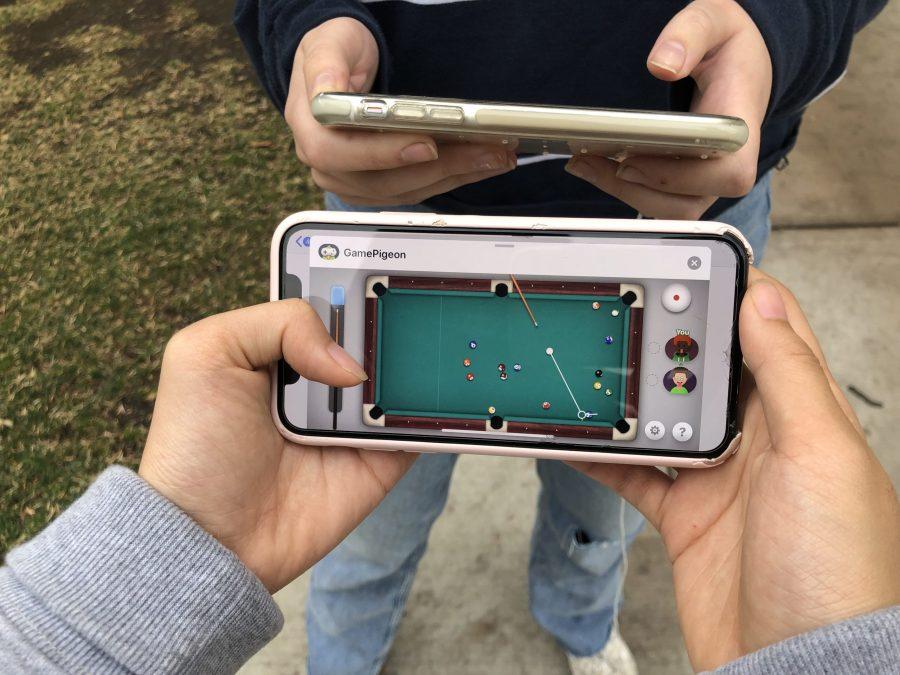When Game Pigeon launched in 2016, it included 8-Ball, Poker, Sea Battle, Gomoku and Anagrams. However, according to junior Zander Darby, the once unassuming iMessage extension is now nearly ubiquitous among Paly students and features 23 games, ranging from Mini Golf to Cup Pong.
According to Darby, Game Pigeon experienced a dramatic rise in popularity following its initial release.
“Game Pigeon became extremely popular within the last five years,” Darby said. “Around 3 years ago, the big game that Game Pigeon provided was 8-Ball pool.”
According to Darby, students quickly created group chats to play Game Pigeon games with each other.
“There were probably around 20 to 25 students in the group chat (I was a part of),” Darby said. “I barely knew any of them because they were all from different grades, but someone would send out a text asking if anybody wanted to play, and every time someone wanted to join.”
Darby said the game allowed him to branch out of his normal social groups.
“I got to know and became more familiar with people in other grades,” Darby said. “I started seeing new names that I had never seen before from the group chat and I was able to recognize everyone on campus.”
Junior Lulu Gaither, who also plays Game Pigeon, said she has used it since seventh grade.
“I think it’s become so popular because it’s easy, quick and is just a simple and fun way to be competitive with your friends,” Gaither said. “I mostly play at school if I’m bored or at home when I should be doing homework.”
According to junior Ziggy Tummalapalli, some students have developed strategies to win.
“I don’t play Game Pigeon too often, but I used to mainly play Cup Pong and 8-Ball,” Tummalapalli said. “8-Ball was pretty competitive. I would often try and put my eye level with the screen to try and see how the predicted line lined up with the hole.”
According to junior Myra Xu, she and her friends sometimes bet on Game Pigeon, using rulers to measure distances on the screen in an effort to improve their odds of winning. Xu said her friends once bet the cost of a boba drink on the outcome of a game.
“It’s a really convenient way to deal with boredom or to start (or) spice up a conversation,” Xu said. “I usually play a game or two of Crazy 8 with a group of friends when we’re all together waiting in line at a restaurant or if we’re just really bored.”
Junior Tommy Hall said most of the students he knows use Game Pigeon, and some students bet on the outcomes of games, usually $5 per person.
“(My friend) was really into it,” Hall said. “He was measuring (distances on the screen) and everything. He told me to leave because he wanted to stay focused.”
Junior Charles Mitz said his friends sometimes playfully tease him for refusing to download the extension.
“I did not download Game Pigeon because of how simple it is to play through texts,” Mitz said. “I would have gotten addicted.”
According to Paly Wellness Outreach Worker Whitney Aquino, the addictive nature of Game Pigeon and other video games might sometimes result in negative outcomes.
“When you lose face to face interaction in favor of text-only, you’re losing a huge part of communication — tone, body language, facial expression, etc.” Aquino said.
Similarly, senior Adam Hashmi said Game Pigeon was often too much fun for his own good.
“It was very exciting to be able to play when I got an iPhone and it was one of the first things I regularly used my phone for,” Hashmi said. “Most know me to be an exceptional student, but one of my biggest weaknesses at school is pesky Game Pigeon.”
According to Aquino, video games in and of themselves are not inherently good nor bad.
“For many people, they are a fun hobby that sometimes even allows the opportunity for connection with others,” Aquino said. “As with anything, too much can be detrimental.”
According to Aquino, students should try to limit excessive use for the optimal experience.
Aquino said, “In moderation, it is a fun and engaging way to connect with others.”



